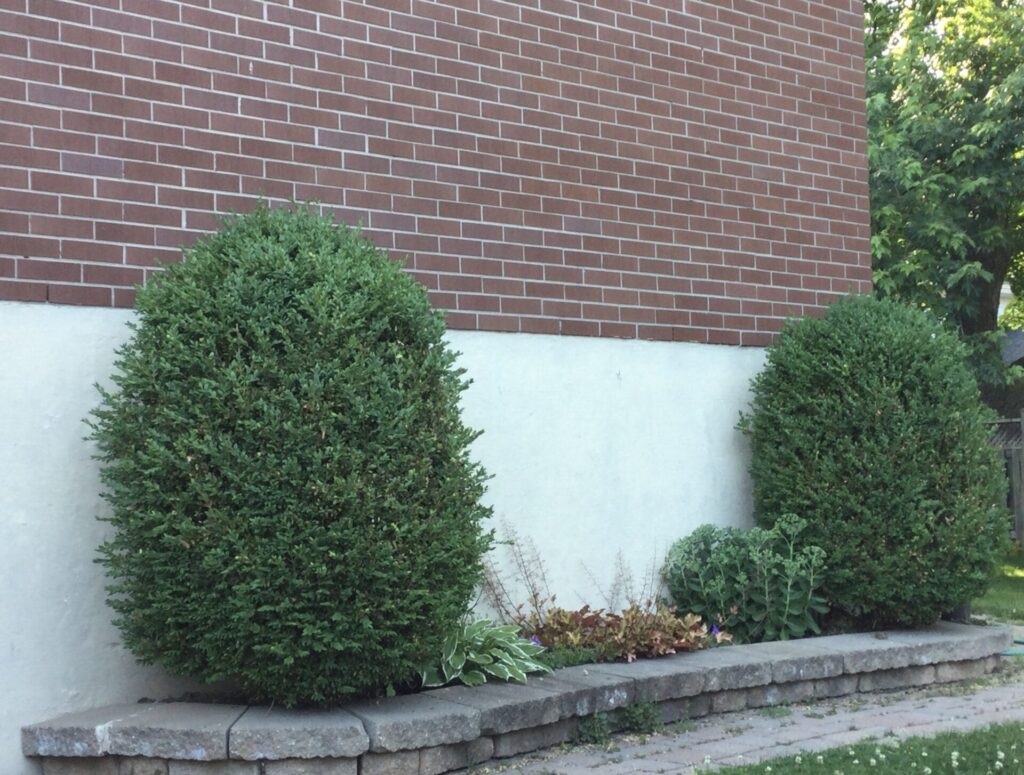
Hello,
I have 2 boxwoods that are about 5 feet tall planted close to the foundation of the house. These have been planted by the our predecessors and were already there when we bought the house 3 years ago.
I have recently read that boxwoods’ roots systems can damage foundations over they years. There is no visible damage to our house’s foundation right now. However, I am concerned that the damage may form over the long term. They damage may also be hidden for a long time.
I am not sure if root barriers were installed…
Can you please offer advice on what to do? Should I consider having them removed? If I do remove them, what would be a good substitute that would provide the same height and presence as the boxwoods?
Thanks,
Kenneth
Yes, Kenneth, your concern is well-founded. Trees or shrubs planted too close to a house can send down roots that harm the foundations or water and sewer pipes, or block air circulation, and cause mold and mildew on the siding.
In your case, the problem is exacerbated because that appears to be a very narrow bed. The picture suggests that it is about 30″ deep at most, far too small a bed for foundation plantings of trees and shrubs. It is recommended that short (3 feet or less) shrubs be at least 3 feet away from the foundation and taller shrubs and trees be at least 5 feet away.
Not now, in the heat and drought of high summer, but in early fall, you could remove the boxwoods, enlarge the bed and replant the boxwoods 5 feet away from the house. Then fill in the rest of the bed with perennials, for a colourful and interesting border, punctuated by the tall evergreen boxwoods.
However, if you are going to this much effort, we would strongly recommend replacing the boxwoods with native shrubs or trees.
In Toronto, boxwoods are under attack by the box tree moth, which can decimate the plant to the extent that it cannot survive. Many homeowners have lost their boxwoods and many others are proactively replacing them with other plants to avoid the problem.
In addition to avoiding this issue, replacing yours with native shrubs and perennials will provide food and shelter for pollinators including hummingbirds, native bees, butterflies and moths.
If you choose not to enlarge the bed, your can still remove the boxwoods and replant the bed with appropriately sized native perennials. For example, Spotted Joe-Pye weed, Eupatorium maculatum, will give you the height you seek, as well as texture and colour, and encourage a variety of butterflies such as tiger swallowtails, monarchs, skippers, and azures. Again, you could surround the Joe-Pyes with smaller perennials to complete the bed. Of course, you would choose the plants based on the sun / shade conditions.
For your consideration, whether or not you enlarge the bed, we have an extensive list of appropriate plants and guides to growing them, and there are many other useful online resources.
Here is a list we have prepared:
Full Sun
Perennials
Anaphalis margaritacea, Pearly Everlasting
Asclepias tuberosa, Butterflyweed
Aster novae-angliae, New England Aster
Campanula rotundifolia,Bluebells/Harebells
Chamerion angustifolium, Fireweed
Coreopsis lanceoleolata, Lance-leaf Coreopsis
Desmodium canadense, Showy Tick Trefoil
Echinacea pallida, Pale Purple Coneflower
Euphorbia corollata, Flowering Spurge
Fragaria virginiana, Wild Strawberry
Geum triflorum, Prairie Smoke
Liatris aspera, Rough Blazing-star
Lupinus perennis, Wild Lupine
Oenothera biennis, Evening Primrose
Ratibida pinnata, Yellow Coneflower
Silpium laciniatum, Compass-plant
Solidago speciosa, Showy Goldenrod
Verbena stricta, Hoary Vervain
Shrubs
Amelanchier alnifolia, Saskatoon Berry
Ceanothus americanus, New Jersey Tea
Juniperus communus, Common Juniper
Prunus pumila, Sand Cherry
Rosa carolina, Carolina RosePart sun/Shade
Part Sun/Shade
Perennials
Allium cernuum, Nodding Wild Onion
Aster laevis, Smooth Blue Aster
Aster oolentangiensis, Sky Blue Aster
Campanula americana, Tall Bellflower
Coreopsis tripteris, Tall Coreopsis
Desmodium canadense, Showy Ticktrefoil
Heliopsis helianthoides, False Sunflower
Maianthemum stellatum, Starry False Solomon’s Seal
Monarda fistulosa, Wild Bergamot
Penstemon digitalis, Foxglove Beardtongue
Rudbeckia hirta, Black-eyed Susan
Tradescantia ohioensis, Ohio Spiderwort
Vernonia missurica, Ironweed
Shrubs
Cornus racemosa, Grey Dogwood
Cornus stolonifera, Red-Osier Dogwood
Corylus americana, American Hazel
Juniperus horizontalis, Creeping Juniper
Physocarpus opulifolius, Ninebark
Shade
Perennials
Actaea rubra, Red Baneberry
Anemone Canadensis, Canada Anemone
Asarum canadense, Wild Ginger
Aster macrophyllus, Large-leaf Aster
Aquilegia canadensis, Canadian Columbine
Frageria virginiana, Wild Strawberry
Geranium maculatum, Wild Geranium
Helianthus divaricatus, Woodland Sunflower
Maianthemum racemosum, False Solomon’s-seal
Podophyllum peltatum, Mayapple
Polygonatum biflorum, Soloman’s Seal
Phlox divaricata, Wild Blue Phlox
Solidago flexicaulis, Zig Zag Goldenrod
Virgin’s Bower, Clematis virginiana
Shrubs
Cornus alternifolia, Alternative Dogwood
Cornus rugosa, Round-leafed Dogwood
Hamemalis virginiana, Witch-hazel
Prunus virginiana, Choke Cherry
Our guide to Pollinator Gardens can be found here:
The City of Guelph has an excellent list: http://guelph.ca › wp-content › uploads › droughtTolerant-NativePlants
The City of Toronto’s is here: https://cvc.ca/wp-content/uploads/2011/02/Fact_2_How_to_Select_and_Buy_Native_Plants.pdf
Credit Valley Conservation Authority has this booklet: https://cvc.ca/wp-content/uploads/2017/04/17-uo-nativeplantsforpollinators-booklet-v8-web.pdf
The North American Native Plant Society also has an excellent site with many tips and resources at https://www.nanps.org/
As you can see, there are many attractive and beneficial options to the boxwoods you inherited when you bought your house.
Best of luck creating a lovely surrounding!

